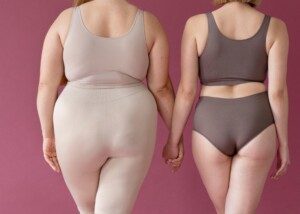Super morbidly obese women are claiming that natural body diversity includes a significant level of overweight.
Just where do we draw the line?
I’ve come upon Instagram and TikTok posts by SMO (super morbidly obese) influencers with messages that clearly translate to: “Natural body diversity includes all kinds of weights, even 400 pounds.”
I wonder if they believe that “natural body diversity” or “normal body diversity” includes adult bodies weighing 70 pounds from anorexia nervosa.
I recently saw a woman in a parking lot whose upper thighs were the same girth as the upper portion of my forearm.
I was surprised she was able to move about without a walker, though she did make every step look painful. I doubt this was cancer.
When people lose weight from cancer but are still able to drive a vehicle into the community (as she had done), they aren’t 70 pounds.
My sister who has stage 4 breast cancer went from a size 12 to a size 4 and is still very active in life. If her disease one day emaciates her body, she’ll be too weak to conduct community errands.
By the time a cancer patient gets down to skeletal weight they’re in hospice and need round-the-clock care.
The woman I witnessed was so frightfully underweight that it could be explained only by anorexia nervosa (and I’ve seen many photos of such in advanced stages).
In short, she looked like a taller version of influencer Eugenia Cooney, who appears 60 pounds soaking wet.
Would these SMO influencers view these skeletal bodies as normal body diversity? I highly doubt it. They even see a size 8 as “too thin.”
Normal Body or Weight Diversity Does NOT Include Morbid Obesity
If it did, we’d see morbid obesity in pretty uniform percentages all over the world, save for famished nations.
Morbid obesity — a body mass index (BMI) of 40 or higher, or being at least 100 pounds overweight — is strongly associated with numerous health complications, including type 2 diabetes, cardiovascular disease and reduced life expectancy (Pi-Sunyer, 2009). Not to mention mobility problems and joint pain.
High levels of fat in the body, particularly around organs, is consistently linked to negative health outcomes across populations (Afshin et al., 2017).
You can be confident as a human being without denying the medical reality that morbid obesity significantly increases disease burden and healthcare costs.
From an evolutionary perspective, morbid obesity is not a normal or adaptive variation in human body diversity.
Human physiology evolved to store fat efficiently during times of scarcity, but not to sustain excessive fat accumulation.
In ancestral environments, food was limited and high energy expenditure was the norm.
Thus, having a fat body would’ve been maladaptive, reducing mobility, fertility and survival – including survival of the human species overall.
This is easy to believe. Have you ever seen a fat herd of impala, gazelle, horse or zebra?
You may be thinking that cows are fat. But actually, their size is mostly muscle, which is why conventional beef comes from grain-fed cows (grain fattens them up) that are also given hormones (to add even more fat). A cow’s natural food source, grass, doesn’t fatten them up.
How often have you seen fat apex predators such as the lion, leopard, cheetah, any other big cat, wolf, hyena, crocodile, eagle or hawk?
Even smaller animals such as the lizard, squirrel and rat are not fat unless overfed by humans. There is just no evolutionary advantage for animals to be fat!
You may think that squirrel outside your window is fat, but if it truly were, it’d have difficulty jumping onto trees, scuttling up branches and deftly ambulating atop narrow fences. A ball of fur doesn’t mean fat.
Few animals in the wild have high amounts of fat, and in those cases, they either spend a lot of time in water or, like bears, hibernate for many months and thus need fat stores.
- A fat human is not the result of evolution or natural body diversity.
- It’s the consequence of lifestyle choices.
Obesity at modern levels — especially morbid — is a consequence of environmental mismatch: abundant high-calorie foods and sedentary lifestyles overwhelming evolved regulatory systems (Speakman, International Journal of Obesity, 2006).
Evolution selected for thrifty genes that favored fat storage, but not for mechanisms to prevent chronic overconsumption of food.
Therefore, the fat human body is a byproduct of modern conditions, not an evolved or naturally diverse body state.
 Lorra Garrick is a former personal trainer certified by the American Council on Exercise. At Bally Total Fitness, where she was also a group fitness instructor, she trained clients of all ages and abilities for fat loss and maintaining it, muscle and strength building, fitness, and improved cardiovascular and overall health.
Lorra Garrick is a former personal trainer certified by the American Council on Exercise. At Bally Total Fitness, where she was also a group fitness instructor, she trained clients of all ages and abilities for fat loss and maintaining it, muscle and strength building, fitness, and improved cardiovascular and overall health.
.










































